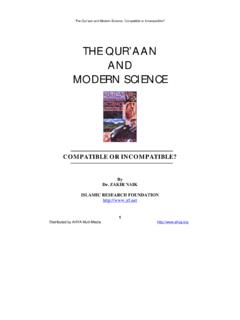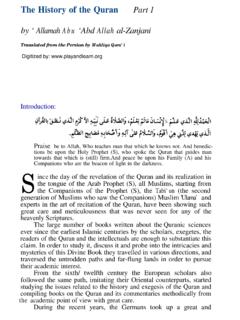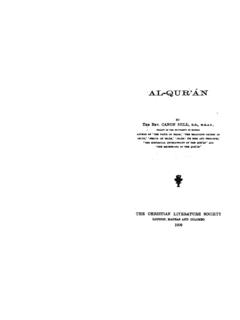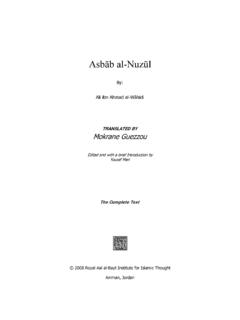Transcription of HOLY QUR’AN SUMMARY - IPCI
1 HOLY QUR'AN. SUMMARY . SUMMARISED VERSION BY. PROFESSOR YOUSUF DADOO. FOR : * taraweeh PURPOSES. * UNDERSTANDING THE MESSAGE OF THE HOLY QUR'AN. ISLAMIC PROPAGATION. CENTRE INTERNATIONAL. 124 Queen Street, Durban, South Africa 4001. PO Box 2439, Durban, South Africa 4000. Telephone +27(0)31 306 0026/7 Facsimile 1 +27(0)31 304 0326. e-mail: Web Site: Detail from frontispiece of a Qur'an produced in Iran in 1313. 2. FOREWORD. One of the key programs of IPCI's founder Sheikh Ahmed Deedat was encouraging Muslims to read the Qur'an with understanding. The IPCI. still continues this legacy by its worldwide distributionof the Holy Qur'an with English translation and commentary.
2 The publishing of this taraweeh SUMMARY by the is another endeavour in providing a concise SUMMARY of the Qur'an for the benefit of the Muslim Ummah. There are many summaries available. This particular publication has been adopted and modified from the Muslim Youth Movement version that was published in 1979. Allah is fully aware of their sterling pioneering efforts and will reward them accordingly. The SUMMARY of the Qur'an would be beneficial if: The relevant section is read at home before going to the Musjid for taraweeh , Read out by someone in the Musjid just before the taraweeh (this should not take more than five (5) minutes), Read all year round to get a bird's eye' synopsis of the Qur'an, As a Dawah tool to let the non-Muslims have a glimpse of the theme, subject matter and style of the Qur'an.
3 The IPCI records its deep gratitude to Professor Yousuf Dadoo for the meticulous manner in which this task has been accomplished. The IPCI. welcomes any suggestions in improving this publication. There is no copyright. If re-printed or translated kindly forward a copy to the IPCI. for our records. 1 Shaban 1426 (corresponding to 6 September 2005). IPCI 124 Queen Street, Durban, South Africa 4001. PO Box 2439, Durban, South Africa 4000. Telephone +27(0)31 306 0026/7 Facsimile +27(0)31 304 0326. e-mail: Web Site: 3. PREAMBLE. All Praise and Glory belong to Allah Who has facilitated the completion of this noble task relating to His Illustrious Book. The recitation of the Holy Qur'an is meant to be a moving experience since it marks Allah's communication with us.
4 Such an event becomes much more meaningful if we understand its message. It was precisely this consideration which encouraged us to present this humble product before the English-speaking Muslim Umma thirty-one years ago. It was felt then that the lessons of this Holy Book, whose full recitation during the taraweeh prayers conventionally covered twenty- seven nights, had to be read each night to the congregation preferably before the commencement of the aforesaid prayers. The following factors were paramount: - The language had to be simple enough for the average listeners. - Its reading was not to exceed seven minutes. - The SUMMARY should, as far as possible, allow the Qur'an to speak for itself without human commentary.
5 The same motivation dictates the SUMMARY 's re-presentation to the audience in a better format. Much water has flowed under the bridge since then: a primary contributor to the original project, Brother Mahmood Moosa, is no longer in our midst. Memories come flooding in as I reflect upon the ardour and candour with which the original draft was assessed at his office in Commercial Road, Durban. No worldly glory is hereby aspired to; all that is sought is Allah's Pleasure on a day when neither kith, nor kin nor social status will guarantee us any success. Translations and reproductions of this work may be made with the prior approval of the publisher. 4. Circumstances surrounding the performance of taraweeh prayers have changed with many local mosques opting to complete full recitation of the Holy Qur'an on the twenty-ninth night of Ramadan instead of the twenty-seventh night.
6 This ought not to complicate the presentation of the relevant SUMMARY for the night if the reader keeps it in tandem with the night's Qur'anic recitation. In fact, these summaries could even be viewed as daily reading matter for us to refresh our minds about the Holy Message throughout the year. Yet these summaries will inevitably have flaws. For instance, while the transcription code for Arabic words is helpful it does not go far enough for giving us exact equivalents for some categories of sounds not occurring in English. But on the other hand, the use of the International Phonetic Alphabet code would have caused its reading (by an average person) to become extremely cumbersome.
7 The following sound equivalents are given: represents the long vowel as in dark . represents the long vowel as in cool . represents the long vowel as in meet . represents the guttural stop ' represents a medial guttural sound The following terms or acronyms are frequent: S rah a chapter of the Holy Qur'an Ras l a messenger Sal t daily obligatory prayer Zak t compulsory charity Hajj pilgrimage 5. Hijra the Holy Prophet's migration from Makka to Mad na in 622. CE. SWT Subhanahu wa ta' l (Glory and Exaltation be His). SAW Salla ll hu 'alayhi wa sallam (May Allah's Salutations and Peace be upon him). AS Alayhi s-salam (Peace be upon him) (Plural: Alayhim us-salam). RA Radiya ll hu anhu/a (May Allah be pleased with him/her).
8 Names of the following prophets, with their biblical equivalents are given below: Adam Adam Ya'q b Jacob Y nus Jonah N h Noah Y suf Joseph Ayy b Job Ibr h m Abraham Bin Yam n Benjamin 'Is Jesus Ism ' l Ishmael Shu'aib Jethro M s Moses Ish q Isaac L t Lot H r n Aaron D w d David Sulaim n Solomon Yahy John Zakariya Zecharia Ily s Elias Idr s Enoch Following the Qur'anic form, the masculine form of address has been often used to include both men and women. No disrespect to women is hereby intended. Yousuf Dadoo, University of South Africa 1 Shaban 1426 (corresponding to 6 September 2005). 6. BISMILLAH IR-RAHMAN IR- RAHIM. IN THE NAME OF ALLAH, MOST BENEFICENT, MOST MERCIFUL.
9 1ST taraweeh . Tonight's taraweeh consists of Alif L m M m and the first quarter of Sayaq l. The S rahs covered are Al-F tiha (The Opening), and the first two- thirds of Al-Baqara (The Cow). The Qur' n begins with the beautiful S rat al-F tiha, containing seven verses and rightly called the Essence of the Book . It has been called by this title for a very obvious reason. It shows the helplessness of man without the aid of Allah (SWT) and his continuous desire for Allah (SWT)'s assistance in all matters affecting his daily life. That is why, by means of this S rah, Allah (SWT) teaches us this perfect prayer and gives us some knowledge of Himself, He describes some of His qualities.
10 Further He tells us about what His relation with us and to the rest of the creation is, from where we have come, what we are, and what goal we are heading for under Allah (SWT)'s guidance. We are to trust and commit ourselves to Allah (SWT) if we want to succeed in this life and in the Hereafter. The second is S rat al-Baqara, The Cow , revealed in Madina and containing 286 verses. It sums up the entire teachings of the Qur' n. The reason for having this S rah second in the arrangement of S rahs is very logical. The essence of the first S rah is man, crying out to Allah (SWT): O Allah (SWT)! Help Me . In the second, S rah Allah (SWT). says: Here is the help and guidance that you need.








